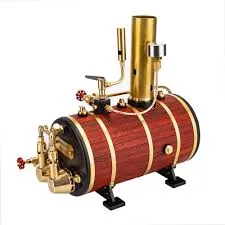
Dec . 18, 2024 01:45 Back to list
coal fired steam boiler china
The Role of Coal-Fired Steam Boilers in China's Energy Landscape
As one of the largest energy consumers in the world, China has been characterized by its heavy reliance on coal as a primary energy source. Among the various technologies employed to harness coal's potential, coal-fired steam boilers have played a pivotal role in the country’s industrial framework, contributing significantly to both electricity generation and industrial processes. This article delves into the significance, advantages, challenges, and future outlook of coal-fired steam boilers in China.
The Significance of Coal-Fired Steam Boilers
Coal-fired steam boilers primarily convert the thermal energy of coal into steam, which can then be used for power generation or industrial heating. In China, these boilers are crucial for a wide array of applications, including manufacturing, energy production, and even district heating systems. The infrastructure supporting coal-fired boilers is extensive, powering factories and providing heat to homes, especially in northern regions of the country where winters can be harsh.
The sheer scale of coal consumption in China has positioned the country as the world’s largest producer and consumer of electricity generated from coal. According to the National Energy Administration, coal accounted for over 57% of the nation's total energy consumption in recent years, solidifying the importance of coal-fired steam boilers in ensuring energy security and supporting the economic growth of the country.
Advantages of Coal-Fired Steam Boilers
Coal-fired steam boilers bring several advantages that contribute to their enduring popularity in China. Firstly, they are capable of generating large volumes of steam, making them suitable for industries with significant heating needs. Secondly, coal is abundantly available and relatively inexpensive compared to alternative energy sources, such as natural gas or renewables, which makes coal-fired boilers an economically viable option for many businesses.
Additionally, advancements in technology have led to more efficient and cleaner coal combustion processes. Modern coal-fired steam boilers are designed with improved emissions control systems, helping to reduce particulate matter and harmful gases such as sulfur dioxide and nitrogen oxides. These developments are crucial for mitigating the environmental impact of coal combustion and for complying with increasingly stringent regulations aimed at reducing air pollution.
coal fired steam boiler china

Challenges Facing Coal-Fired Steam Boilers
Despite their advantages, coal-fired steam boilers do face a number of challenges. The primary concern revolves around environmental sustainability. The burning of coal is a significant contributor to greenhouse gas emissions, which has led to global calls for a shift towards cleaner energy sources. As a result, China is at the crossroads of balancing economic growth with environmental responsibilities.
Furthermore, international commitments to reduce carbon emissions—exemplified by the Paris Agreement—compel China to advance its energy transition. As part of this transition, there is growing investment in renewable energy technologies, such as wind and solar, which poses a challenge to the continued dominance of coal-fired power generation.
Additionally, aging infrastructure and maintenance issues can affect the efficiency and reliability of existing coal-fired steam boilers. The need for modernization and upgrades is crucial to ensure that these units remain competitive in a rapidly evolving energy landscape.
The Future Outlook
Looking ahead, the future of coal-fired steam boilers in China will likely be characterized by a dual approach. While the country continues to depend on coal in the short to medium term, there is a pressing need to integrate cleaner technologies and explore alternative energy sources. The development of carbon capture and storage (CCS) technology presents an opportunity to enhance the sustainability of coal-fired power generation and address environmental concerns.
Furthermore, as China strives to achieve its carbon peak before 2030 and carbon neutrality by 2060, energy diversification will become increasingly vital. Policymakers are encouraged to pursue a balanced energy portfolio that combines fossil fuels with renewable energy sources. In particular, investments in modern, efficient coal-fired steam boilers that minimize emissions can play a role in this transition.
In conclusion, coal-fired steam boilers remain an integral part of China’s energy infrastructure. As the nation grapples with the challenges of transitioning towards a more sustainable energy system, the future of coal-fired steam boilers will depend on advancements in technology, regulatory frameworks, and the broader trends in energy consumption. Balancing economic needs with environmental responsibilities will be crucial in shaping the role of coal in the years to come.
-
High-Efficiency Commercial Oil Fired Steam Boiler for Industry
NewsJul.30,2025
-
High-Efficiency Biomass Fired Thermal Oil Boiler Solutions
NewsJul.30,2025
-
High Efficiency Gas Fired Thermal Oil Boiler for Industrial Heating
NewsJul.29,2025
-
High-Efficiency Gas Fired Hot Water Boiler for Sale – Reliable & Affordable
NewsJul.29,2025
-
High Efficiency Biomass Fired Hot Water Boiler for Industrial and Commercial Use
NewsJul.29,2025
-
High-Efficiency Biomass Fired Hot Water Boiler for Industrial Use
NewsJul.28,2025
Related PRODUCTS






















